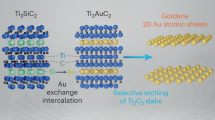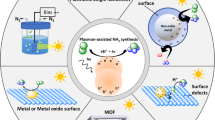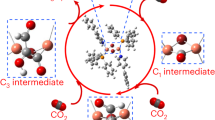Abstract
Catalysis using gold is emerging as an important field of research in connection with ‘green’ chemistry1,2,3. Several hypotheses have been presented to explain the markedly high activities of Au catalysts4,5,6,7,8,9,10. So far, the origin of the catalytic activities of supported Au catalysts can be assigned to the perimeter interfaces between Au nanoclusters and the support11. However, the genesis of the catalytic activities of colloidal Au-based bimetallic nanoclusters is unclear. Moreover, it is still a challenge to synthesize Au-based colloidal catalysts with high activity. Here we now present the ‘crown-jewel’ concept (Supplementary Fig. S1) for preparation of catalytically highly Au-based colloidal catalysts. Au–Pd colloidal catalysts containing an abundance of top (vertex or corner) Au atoms were synthesized according to the strategy on a large scale. Our results indicate that the genesis of the high activity of the catalysts could be ascribed to the presence of negatively charged top Au atoms.
This is a preview of subscription content, access via your institution
Access options
Subscribe to this journal
Receive 12 print issues and online access
$259.00 per year
only $21.58 per issue
Buy this article
- Purchase on Springer Link
- Instant access to full article PDF
Prices may be subject to local taxes which are calculated during checkout




Similar content being viewed by others
References
Enache, D. I. et al. Solvent-free oxidation of primary alcohols to aldehydes using titania-supported gold–palladium catalysts. Science 311, 362–365 (2006).
Comotti, M., Della Pina, C., Falletta, E. & Rossi, M. Is the biochemical route always advantageous? The case of glucose oxidation. J. Catalys. 244, 122–125 (2006).
Hughes, M. D. et al. Tunable gold catalysts for selective hydrocarbon oxidation under mild conditions. Nature 437, 1132–1135 (2005).
Herzing, A. A., Kiely, C. J., Carley, A. F., Landon, P. & Hutchings, G. J. Identification of active gold nanoclusters on iron oxide supports for CO oxidation. Science 321, 1331–1335 (2008).
Haruta, M. Gold as a novel catalyst in the 21st century: Preparation, working mechanism and applications. Gold Bull. 37, 27–36 (2004).
Wang, J. G. & Hammer, B. Oxidation state of oxide supported nanometric gold. Top. Catal. 44, 49–56 (2007).
Lopez, N. et al. On the origin of the catalytic activity of gold nanoparticles for low-temperature CO oxidation. J. Catalys. 223, 232–235 (2004).
Sanchez, A. et al. When gold is not noble: Nanoscale gold catalysts. J. Phys. Chem. A 103, 9573–9578 (1999).
Xu, Y. & Mavrikakis, M. Adsorption and dissociation of O2 on gold surfaces: Effect of steps and strain. J. Phys. Chem. B 107, 9298–9307 (2003).
Haruta, M. & Daté, M. Advances in the catalysis of Au nanoparticles. Appl. Catal. A 222, 427–437 (2001).
Haruta, M. When gold is not noble: Catalysis by nanoparticles. Chem. Rec. 3, 75–87 (2003).
Chen, M. S., Kumar, D., Yi, C. W. & Goodman, D. W. The promotional effect of gold in catalysis by palladium–gold. Science 310, 291–293 (2005).
Edwards, J. K. et al. Switching off hydrogen peroxide hydrogenation in the direct synthesis process. Science 323, 1037–1041 (2009).
Sun, Y. G. & Xia, Y. N. Shape-controlled synthesis of gold and silver nanoparticles. Science 298, 2176–2179 (2002).
Campbell, C. T. The active site in nanopaticle gold catalysis. Science 306, 234–235 (2004).
Lemire, C., Meyer, R., Shaikhutdinov, S. & Freund, H. J. Do quantum size effects control CO adsorption on gold nanoparticles? Angew. Chem. Int. Ed. 43, 118–121 (2004).
Zanella, R., Giorgio, S., Shin, C. H., Henry, C. R. & Louis, C. Characterization and reactivity in CO oxidation of gold nanoparticles supported on TiO2 prepared by deposition-precipitation with NaOH and urea. J. Catalys. 222, 357–367 (2004).
Toshima, N., Kanemaru, M., Shiraishi, Y. & Koga, Y. Spontaneous formation of core/shell bimetallic nanoparticles: A calorimetric study. J. Phys. Chem. B 109, 16326–16331 (2005).
Toshima, N., Ito, R., Matsushita, T. & Shiraishi, Y. Trimetallic nanoparticles having a Au-core structure. Catal. Today 122, 239–244 (2007).
Li, Z. Y. et al. Three-dimensional atomic-scale structure of size-selected gold nanoclusters. Nature 451, 46–48 (2008).
Ajayan, P. M. & Marks, L. D. Experimental-evidence for quasimelting in small particles. Phys. Rev. Lett. 63, 279–282 (1989).
Egerton, R. F. Electron Energy Loss Spectroscopy in the Electron Microscope (Plenum, 1996).
Comotti, M., Della Pina, C., Matarrese, R. & Rossi, M. The catalytic activity of naked gold particles. Angew. Chem. Int. Ed. 43, 5812–5815 (2004).
Zambelli, T., Wintterlin, J., Trost, J. & Ertl, G. Identification of the active sites of a surface-catalyzed reaction. Science 273, 1688–1690 (1996).
Vang, R. T. et al. Controlling the catalytic bond-breaking selectivity of Ni surfaces by step blocking. Nature Mater. 4, 160–162 (2005).
Tsunoyama, H., Ichikuni, N., Sakurai, H. & Tsukuda, T. Effect of electronic structures of Au clusters stabilized by poly(N-vinyl-2-pyrrolidone) on aerobic oxidation catalysis. J. Am. Chem. Soc. 131, 7086–7093 (2009).
Chaki, N. K., Tsunoyama, H., Negishi, Y., Sakurai, H. & Tsukuda, T. Effect of Ag-doping on the catalytic activity of polymer-stabilized Au clusters in aerobic oxidation of alcohol. J. Phys. Chem. C 111, 4885–4888 (2007).
Kim, Y. D., Fischer, M. & Ganteför, G. Origin of unusual catalytic activities of Au-based catalysts. Chem. Phys. Lett. 377, 170–176 (2003).
Beltrame, P., Comotti, M., Della Pina, C. & Rossi, M. Aerobic oxidation of glucose II. Catalysis by colloidal gold. Appl. Catal. A 297, 1–7 (2006).
Acknowledgements
This work was financially supported by Grants-in-Aid from the Core Research for Evolutional Science and Technology (CREST) program sponsored by the Japan Science and Technology Agency (JST).
Author information
Authors and Affiliations
Contributions
M.H. and N.T. planned the project, H.Z. designed and carried out experiments and data analyses, T.W. helped with ICP data analyses, M.O. carried out DFT calculation, N.T. proposed and supervised the project and H.Z. and N.T. prepared the manuscript. All the authors participated in discussion of the research.
Corresponding author
Ethics declarations
Competing interests
The authors declare no competing financial interests.
Supplementary information
Supplementary Information
Supplementary Information (PDF 1149 kb)
Rights and permissions
About this article
Cite this article
Zhang, H., Watanabe, T., Okumura, M. et al. Catalytically highly active top gold atom on palladium nanocluster. Nature Mater 11, 49–52 (2012). https://doi.org/10.1038/nmat3143
Received:
Accepted:
Published:
Issue Date:
DOI: https://doi.org/10.1038/nmat3143
This article is cited by
-
Small, solubilized platinum nanocrystals consist of an ordered core surrounded by mobile surface atoms
Communications Chemistry (2024)
-
Fundamentals and catalytic applications of single-atom alloys
Science China Materials (2024)
-
Emerging single-atom nanozymes for catalytic biomedical uses
Nano Research (2023)
-
Atomically dispersed golds on degradable zero-valent copper nanocubes augment oxygen driven Fenton-like reaction for effective orthotopic tumor therapy
Nature Communications (2022)
-
Exploring electronic-level principles how size reduction enhances nanomaterial surface reactivity through experimental probing and mathematical modeling
Nano Research (2022)



